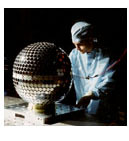

Michael A. Savell.
 
|
John Vasquez of the Naval Research
Laboratory prepares Starshine 1 for
vibration test. Photo by Michael A. Savell. |
|
STARSHINE 4/5 UPDATE - MARCH 21, 2002Please finish your mirrors and put them in the mail to Starshine Headquarters AS SOON AS POSSIBLE. We will inspect them and select one mirror from each returned box for the Starshine 4 satellite. We do not expect to receive polished mirrors back from more than 60% of the 1000 schools and other groups that requested Starshine 4 mirror kits, based on past experience, so we hope that most of the groups that do respond will send us two polished mirrors, as requested in the instructions. We will use the best of the extra mirrors to complete the satellite. AS OF APRIL 7, WE HAVE RECEIVED ONLY 657 USABLE MIRRORS, SO WE STILL HAVE A LONG WAY TO GO. If you are in an overseas school that received its kit late because of shipping delays that were encountered between the U.S. and your country, we will make a special extension to the deadline. Please send an email to gilmoore12@aol.com to let us know when you received your kit and when you expect to get your polished mirrors into the mail.
|

|
Please do not forget to send along your signed name sheets to Starshine
Headquarters, 3855 Sierra Vista Road, Monument, Colorado 80132-8216 USA,
so Phyllis Moore can scan them onto a CD-ROM, as she is doing here, for
placement inside the Starshine 4 satellite.
To view a list of the schools and other
groups participating in the Starshine 4/5 mission, click here.
In the middle of April, we'll take your polished mirrors to the Space Optics Manufacturing Technology Center of NASA's Marshall Space Flight Center in Huntsville, Alabama, for the application of a thin, clear, protective silicon dioxide coating. The coating's actual thickness is 2700 Angstroms, which is one-half wavelength of the light you used to measure the flatness of your completed mirrors. This coating will protect the surface of your mirrors from becoming converted into aluminum oxide by reacting with atomic |
|
improved the hole drilling pattern on this satellite, so we'll be able to
mount 1000 mirrors and 31 laser retroreflectors on its external shell. Skip
Dopp of the Bridgerland Applied Technology College in Logan, Utah, has
obtained spun aluminum structural hemispheres for this satellite, and his
team has started drilling mirror mounting holes in them. The team is also
machining some of the spacecraft's internal structural components and
retroreflector mounts, as well as the shell of the Starshine 5 subsatellite.
We have recently changed our plans for the Starshine 4/5 mission. Instead of releasing an inflatable balloon from inside the Starshine 4 satellite, we're going to release a 4 inch (10 cm) hollow aluminum sphere, instead, which we'll name Starshine 5. This small subsatellite will be released shortly after Starshine 4 is deployed from Space Shuttle Atlantis in January 2003. Both Starshines 4 and 5 will carry 31 laser retroreflectors on their surfaces and will be tracked by the International Satellite Laser Ranging Network (ISLR) and the U.S. Space Command. In addition, Starshine students will visually track the faint flashes of sunlight reflecting from 1000 polished mirrors mounted on the surface of Starshine 4. All these data will be combined to determine the orbit of Starshine 4. Starshine 5 will have no mirrors and will thus not be naked-eye visible, so we will depend totally on ISLR and Space Command tracking for orbit determination of this satellite. By comparing the orbital decay rates of Starshines 4 and 5, it will possible for us to determine the density of the earth's atmosphere more precisely than we've been able to do on previous missions.
|
Return to Project Starshine Home Page
Last Updated: March 21, 2002